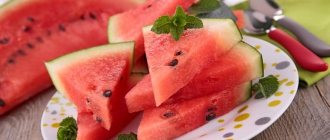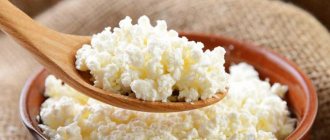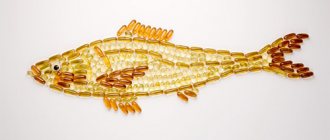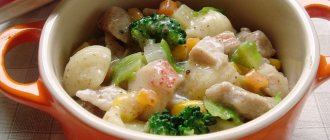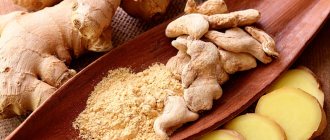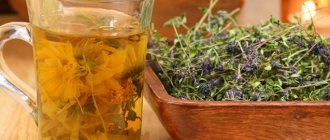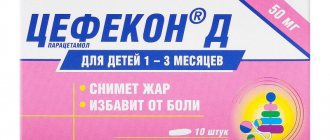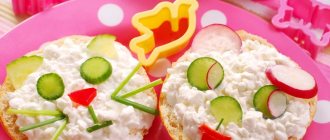The benefits of corn porridge for a child
Porridge made from corn grits or flour is very healthy, the main thing is to prepare it correctly. The composition includes substances necessary for the proper physical development of the baby.
Composition and nutritional value
Cereals for making porridge are rich in proteins and healthy carbohydrates. Corn also contains:
- Coarse plant fiber that stimulates intestinal function;
- Essential amino acids;
- Large amount of potassium;
- Vitamins B and C.
Regular consumption of any dishes made from corn grits (flour) has a beneficial effect on digestion and saturates the body with proteins necessary for the proper development of bone and muscle systems. Potassium strengthens the heart muscle and provides energy. Therefore, healthy corn porridge must be included in children's diets.
The dish is rich in vitamins and minerals
Benefits and harms
Corn porridge for babies is a necessary link in the menu and has many advantages:
We recommend reading: Dishes for children under one year old
- it does not contain the protein gluten, which causes allergies in some babies;
- porridge is very low in calories, so it is well absorbed by the child’s digestive system;
- has a good effect on the immune system, has an effective effect after the use of antibiotics, stimulates the body’s defense reactions;
- cleanses and strengthens the circulatory system, helps the heart function; corn also contains acids that remove unnecessary toxins from the body;
- due to the presence of glutamic acid in corn porridge, the child calms down, so it is recommended to prepare it for hyperactive children and during teething;
- normalizes stool, especially when the baby is constipated;
- gives health to hair and skin;
- improves mood.
But parents need to take into account that there are negative aspects if you use corn dishes in large quantities and very often:
- phosphorus in porridge interferes with the absorption of calcium, which is undesirable for the child’s developing skeletal system and growing teeth;
- a violation of the water-salt and acid-base balance is possible, so this dish should be removed from the diet of children with problems with the duodenum and stomach;
- If you have fiber intolerance, your baby may experience stomach and intestinal upset, abdominal pain, bloating, colic, and nausea. Then this porridge must be excluded from the baby’s diet.
Now you know the benefits and harms of corn porridge, and you can determine how important it is for your child.
How to choose the right cereal
Milk porridge for a child - goat milk for a baby
Corn porridge for babies should be prepared from a high-quality product. When choosing it, you should pay attention to:
- Best before date;
- Packaging integrity;
- Content uniformity;
- No unpleasant odors.
If the cereal looks damp, it may not have been stored properly in the warehouse. Such a product quickly loses its taste and nutritional value and, of course, is unsuitable for baby food. You can also buy ready-made instant corn porridge for young children of domestic or foreign production - this is a product that does not require pre-cooking. In this case, the expiration date is also very important.
How to include corn porridge in complementary foods
- Corn porridge can be given to infants after 8-9 months after including buckwheat and rice porridge in the baby’s diet;
- When introducing complementary foods, do not forget about breastfeeding. Adult food should replace breast milk gradually. Over the course of several months, the amount of breast milk and the duration of feedings are gradually reduced, and the number of new foods and portions of complementary foods are increased. Many pediatricians recommend breastfeeding children until 1.5-2 years of age;
- For the first time, give your baby 1⁄2-1 teaspoon of ready-made porridge to try and watch the baby’s reaction. If there are no negative consequences, cereals can be given to the baby;
- Gradually increase the portion. The norm of corn porridge for a child of 8-9 months is 150 grams, by the year it increases to two hundred grams;
- It is not necessary to give corn porridge to infants often - up to twice a week;
- If you notice abnormal bowel movements, symptoms of food allergies or poisoning, temporarily eliminate the dish from your diet and contact your pediatrician;

- At first, cook only with water. Milk porridges are difficult to digest and often cause allergies, so this diet should not be introduced before 10-12 months;
- The preparation of this porridge for a child under one year old is done without salt, sugar and spices. For taste, add a little breast milk or ready-made milk formula, or vegetable or butter to the dish. Sugar and salt in small quantities are acceptable for children over 1 year old;
- If the baby tolerates grains normally, vegetables, meat and fish are gradually included in the cooking recipe. But keep in mind that each ingredient must be entered into the menu separately;
- Before cooking, corn grits are thoroughly sorted and washed. And after cooking, you need to wait until the food has cooled to room temperature and only then give it to the child;
- Prepared porridge can be stored in the refrigerator for no more than 24 hours in a tightly closed container. Then the dish is heated in a water bath. However, it is better and healthier to prepare new porridge before each meal.
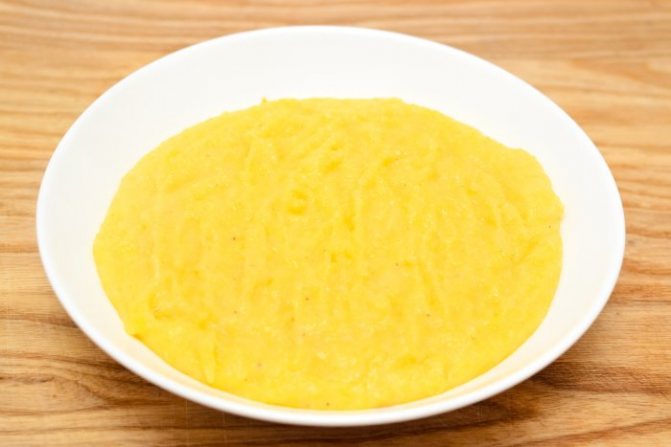
Corn porridge for first feeding
Hercules decoction for infants with milk and water
Pediatricians often recommend this tasty dish for first feeding because it:
- Well absorbed;
- Helps you feel full quickly;
- Improves intestinal function;
- Benefits children suffering from vitamin deficiencies;
- Does not cause a feeling of heaviness in the stomach.
Interestingly, after heat treatment, the cereal retains all its beneficial properties. This is what distinguishes corn, for example, from rice. But for this, the cereal must be prepared correctly.
You can introduce porridge cooked in water without milk into your baby’s diet starting at 7 months, after buckwheat and rice. If your baby is not gaining weight well, it is best to start with porridge. For well-fed children, it is recommended to introduce vegetable puree first.
When to introduce corn porridge
Despite the fact that this product does not contain gluten, doctors do not recommend giving corn porridge until 8-9 months. As a rule, the introduction of such dishes begins with buckwheat and rice, gradually preparing the baby’s intestines for new treats.
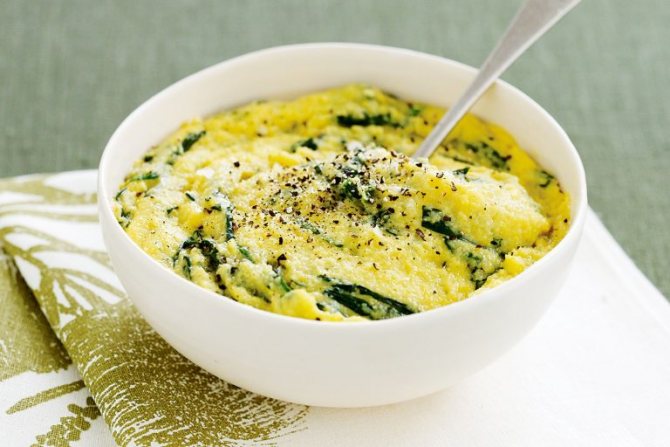
Pediatricians do not advise starting complementary feeding with porridge for infants in principle, since it is believed that they contribute to active weight gain. However, everything is individual: if the baby is really small for his age, a high-calorie dish will be the best option for starting complementary feeding. Another reason for introducing cereal dishes is a negative reaction of the baby’s intestines to vegetables. For example, zucchini can unnecessarily relax the gastrointestinal tract. The appearance of green color in stool is a reason to postpone such vegetables to a later time. Then you can also offer your baby porridge. But it’s still better if it’s buckwheat.
How to cook corn porridge correctly
Prune puree for babies - how to introduce it into complementary foods
A hot dish of corn grits is cooked in a saucepan on a gas stove or in a slow cooker. Infants do not require any flavoring additives. For children over one year old, you can add a little to the porridge:
- Salts;
- Sahara;
- Fresh berries in season;
- Small pieces of fruit.
The finished dish has a pleasant taste and golden yellow color.
How to cook with water
Pour boiling water over the cereal, reduce the heat to low and cook for 30 minutes. If the porridge is intended for a baby up to 7 months of the first year of life, the child is given corn broth filtered through a sieve. No salt is added. This dish is very easy to prepare.
How to cook in a slow cooker
This recipe is suitable for babies from one to three years old. Water, milk and cereal are placed in a bowl. Next, the rice cooking mode is set; the dish must be cooked until fully cooked. The multicooker signal will notify the housewife about the completion of the process. To keep your food warm throughout the day, you can set the device to automatic heating mode.
Corn flour porridge
Cooking a dish according to this recipe is easy. The cereal is ground in a coffee grinder. The resulting flour is briefly poured with cold water. Then it is poured into a pan of boiling water and stirred all the time so that there are no lumps. Cooking time is fifteen minutes. If the baby refuses to eat an unsalted or unsweetened dish, you can add a little salt or sugar.

The dish is good for first feeding
Complementary feeding norms by month
Parents decide for themselves which complementary foods will be the first. In any case, it should be introduced gradually. At 6-7 months, the recommended amount of food is 20 grams, then complementary feeding norms will be as follows:
- 8 months – 40 gr.;
- 9 months – 60 gr.;
- 10 months – 100 gr.;
- 1 year – 150 gr.
Attention! Soviet pediatricians argued that the first complementary foods can be introduced as early as four months. Now the point of view has changed. If a breastfed baby develops normally, you should not introduce porridge before six months. The newborn should receive only formula or breast milk.
How often to give
You can give corn porridge as complementary food, like any other, every day. There will be no harm from this, only benefit. The main thing is to follow the recommended proportions. If the baby is breastfed, one breastfeeding should be gradually replaced with a corn dish.
Attention! Any baby's complementary feeding starts with half a teaspoon. Even if the child asks for more, the dose should not be increased. This is done gradually to prevent unwanted reactions.
Quantity
Corn grits are a very filling product, so the maximum amount of food at one time should be no more than 200 grams. The frequency of including the product in the daily diet is no more than once a day. Children from one year old can eat porridge 2-3 times a day; in this case, a corn dish can be served, for example, for breakfast and dinner.
What can be combined with
The product itself has a pleasant taste, so there is no need to specifically add anything to the porridge to improve the taste. Children who already have teeth can eat a ready-made dish with a piece of white or black bread. Porridge with pieces of fresh seasonal fruit or cooked in vegetable broth has an interesting taste. If your baby refuses to eat, you should not force him. Perhaps, when a little hungry, the baby will appreciate the delicious porridge.
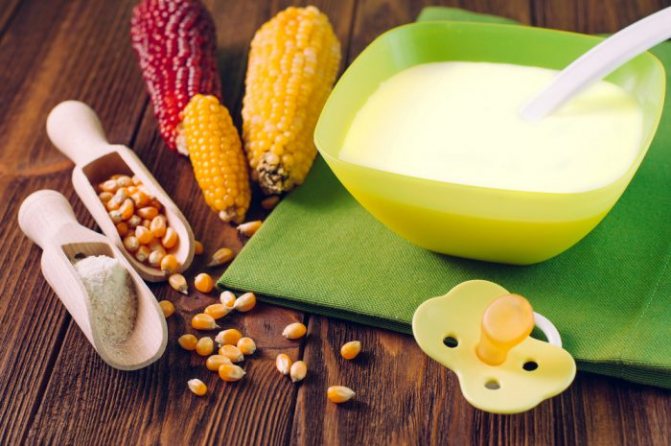
The porridge has a pleasant taste and beautiful appearance
Possible nutrition problems
Since the dish is rich in protein, overeating can lead to increased gas formation, flatulence, bloating, and constipation in infants. Eating stale food may cause diarrhea or stomach upset.
It is also known that too early and rapid introduction of healthy complementary foods accelerates breastfeeding in a breastfed infant. To avoid possible troubles and harm to health, special attention should be paid to maintaining breastfeeding. To do this, new food is introduced in small portions, then the body will positively perceive the new dish.
Before introducing any complementary foods into your baby’s diet, you should consult with your pediatrician. You should also keep in mind that corn, like buckwheat, can cause allergies or individual tolerance. If a skin rash or other unpleasant allergy symptoms appear, the new dish should be excluded from the children's diet.
